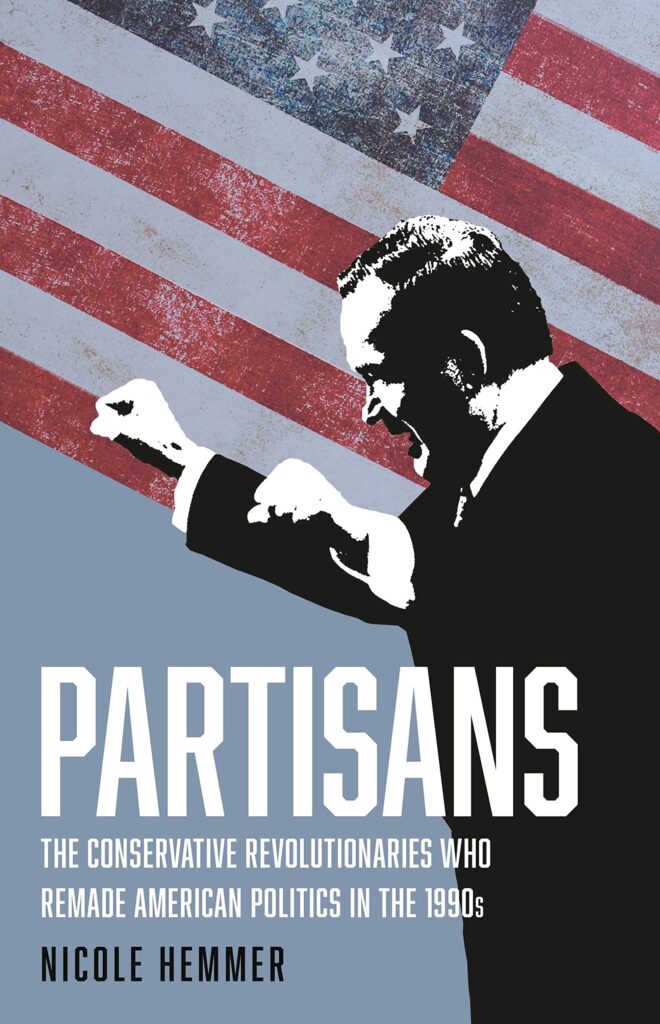Partisans: The Conservative Revolutionaries
Who Remade American Politics in
the 1990s.
by Nicole Hemmer
Basic Books
368 pp., $32.00

During the second debate of the 2016 Republican presidential primary, held at the Reagan Library in Simi Valley, California, almost all candidates adopted the mantle of Ronald Reagan for their own presidential ambitions. When the moment was right, from domestic and foreign policy to national defense, all the candidates—Jeb Bush, John Kasich, Scott Walker, Ted Cruz, Rand Paul, Mike Huckabee, Ben Carson, and Chris Christie—promised to continue in Reagan’s footsteps. All, except one: Donald Trump.
“Trump understood something the debate moderators and other candidates did not: the age of Reagan was over. It had been over for a long time,” Hemmer writes in her book, which deplores Trump’s decision to depart from the trail blazed by the Gipper. The optimism of Reagan’s “Morning in America” gradually faded away into nativist-populist fanaticism, according to Hemmer’s description of the GOP’s right-ward shift. She blames an assortment of familiar characters for stirring a discontent among the Republican base that enabled the emergence of Trump. Among others, she includes talk-radio hosts Rush Limbaugh, G. Gordon Liddy, and Bob Grant; Fox News media moguls Rupert Murdoch and Roger Ailes; TV talking heads Lou Dobbs, Pat Buchanan, John McLaughlin, and Bill Maher, as well as their telegenic blonde counterparts Ann Coulter, Laura Ingraham, and Kellyanne Conway; conservative politicians Newt Gingrich, Bob Barr, and Helen Chenoweth; and religious conservatives Pat Robertson and Ralph Reed.
Hemmer, a political historian and Vanderbilt University professor, highlights the role that these public figures played in moving the GOP and its conservative base beyond the romanticism of the Reagan era. Her account nonetheless is a rambling guilt-by-association narrative that could only be seen as insightful by Gen Z progressives and viewers of MSNBC and CNN.
What Hemmer gets right is that while the GOP establishment remained stuck in the the triumphalism of the Reagan years, the populist base of the party started to notice that its leadership did not seem to care about unrestricted free trade, NAFTA, amnesty for illegal aliens, weak immigration controls, endless foreign wars, boundless commitments to NATO, and a nation transforming from a “shining city on a hill” into a Third-World landfill. Those who noticed these national trends—chiefly paleoconservatives—were ostracized by the establishment right’s official mouthpiece, National Review, as “Unpatriotic Conservatives.”
Disenchantment with Republican elites and the perception that they were nothing more than an out-of-touch political class that put special interests above the national interest occurred under the one-term presidency of Bush the Elder. He allowed the purging of conservatives from the federal bureaucracy and caved on his promise not to raise taxes. The conservative electorate, restless and ready to punish Bush for what Newsweek described as “the wimp factor,” abandoned Reagan’s former vice president in the face of insurgent primary opponents. Pat Buchanan, in his speech to the 1992 Republican Convention in Houston, described a “cultural war … for the soul of America.” Buchanan’s talking points on the forgotten men and women of the Middle American rust belt became a major campaign theme of Ross Perot. As an independent candidate, Perot won over 18 percent of the popular vote even after awkwardly exiting from the presidential race in mid-July 1992.
Eight years of George W. brought on Bush-dynasty fatigue; eight years of Obama sowed further discontent with the political establishment. The Tea Party Movement during Obama’s first term fizzled out after being co-opted by the conservative establishment. Finally, one candidate, Donald Trump, a political outsider, upended the political elites by winning an upset victory over Hillary Clinton, who was thought by the mainstream press to be unbeatable.
This narrative will read like triumph to a reader of this magazine, but is a tragedy in the eyes of Hemmer, who laments that during the 1990s this unsavory band of far-right partisans laid the groundwork for Trump’s rise by stoking hostility toward the conservative political establishment. To Hemmer, the good guys are unsurprisingly left-leaning moderates, and the bad guys are anyone to the right of George Will. John McCain is a “rock-solid conservative” while Lou Dobbs is a “nativist” and promoter of “racist conspiracy.” Mitt Romney is a reasonable “conservative alternative to John McCain,” while undercover documentary maker James O’Keefe is the worst of a “new generation of right-wing scandalmongers;”
Unsurprisingly, Hemmer sees Buchanan as the prime mover among these political iconoclasts. She devotes a great deal of vitriolic ink to the former Nixon speechwriter and three-time presidential candidate: He’s an anti-democratic, anti-immigrant, anti-Semite, racist, Holocaust-denying far-right authoritarian, and angry reactionary.
Representing the fairer sex in what Hemmer calls “Angry White Men—and Women” is Helen Chenoweth, the former congresswoman from Idaho and passionate gun rights defender. She takes center stage in Hemmer’s recounting of Ruby Ridge, the 1992 siege of Randy Weaver’s Idaho property by U.S. Marshals. Hemmer dubiously lays responsibility for Weaver, who was motivated by white separatism, at the feet of Chenoweth, the “Sagebrush Rebel,” whose district encompassed 19 Idaho counties. She does this through a guilt-by-association description of the activities of a mishmash of unsavory reactionaries, from the militia movement and Posse Comitatus to the Oklahoma City bombers Timothy McVeigh and Terry Nichols. According to Hemmer, Chenoweth, who once described white males as an endangered species, was never adequately punished for giving ideological support to the right-wing fringe.
An indication of Hemmer’s superficial knowledge of the contemporary American right is her dismissal of Samuel Francis, a former contributing editor to Chronicles and an award-winning editorial writer and columnist for The Washington Times, as a fringe “white nationalist.” She does not acknowledge, as did Rush Limbaugh, that the political ideas of Francis formed the foundation of Trump’s major campaign themes, particularly his appeal to the forgotten Middle Americans who work hard, live frugally, pay taxes, and who subsidize and serve in the military of the federal Leviathan, but whose concerns are ultimately written off after their votes are cast.
In a similar fashion, Hemmer attempts to dismiss a whole class of 1990s writers who she claims influenced the Trump phenomenon as traffickers in a “new racism” thinly disguised as human intelligence research. She names Charles Murray and Richard Herrnstein’s The Bell Curve as the chief example, followed by Alien Nation by Peter Brimelow, and Dinesh D’Souza’s The End of Racism.
“Both authors of The Bell Curve had trafficked in racist ideas before the book’s publication,” Hemmer writes. “Herrnstein’s were more explicitly racist, while Murray’s were subtler.”
In an attempt to backup this smear of Murray and Herrnstein, Hemmer states that Herrnstein “had been on the race-IQ beat for almost a quarter of a century, part of a renaissance of scientific racism repackaged around contemporary intelligence research.” Hemmer then cites as evidence Herrnstein’s article titled “I.Q.” in the September 1971 edition of The Atlantic. The bulk of the article is a defense of IQ tests, not only as a reasonably accurate measure of mental ability but also an indicator of success and social standing. The piece devotes very little space to race or race differences in IQ. In fact, Herrnstein’s assessment of a landmark analysis of the genetic basis of IQ in the Winter 1969 Harvard Educational Review, “How Much Can We Boost IQ and Scholastic Achievement?” offers a more reserved position on racial differences in intelligence. He wrote:
Although there are scraps of evidence for a genetic component in the black-white difference, the overwhelming case is for believing that American blacks have been at an environmental disadvantage. To the extent that variations in the American social environment can promote or retard I.Q., blacks have probably been held back. But a neutral commentator (a rarity these days) would have to say that the case is simply not settled, given our present stage of knowledge. To advance this knowledge would not be easy, but it could certainly be done with sufficient ingenuity and hard work. To anyone who is curious about the question and who feels competent to try to answer it, it is at least irritating to be told that the answer is either unknowable or better not known, and both enjoinders are often heard.
Unfortunately for Hemmer and likeminded ideologues who would like to punish anyone who dares to bring up the subject of IQ, the work of Herrnstein and Murray is now considered mainstream in social science, though that hasn’t stopped hostile academics from smearing them with ad hominem diatribes.
Hemmer’s treatment of Herrnstein and Murray is of a piece with the intellectually shallow and superficial nature of her book as a whole. Her flippant dismissal of the thinkers and politicians who inspired the “America First” populism that brought Trump into the Oval Office is meant to preach to an ignorant progressive readership rather than to provide insight into her subject. Partisans is a product of contemporary political discourse—made up of cut-and-paste, second- and third-hand source-filled rants—that fails to pass for serious scholarship.



Leave a Reply